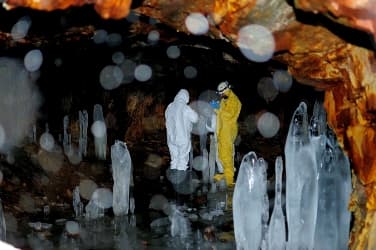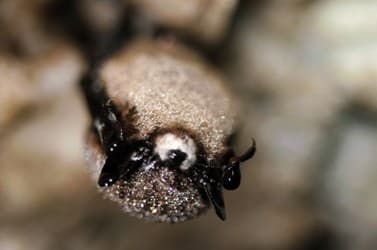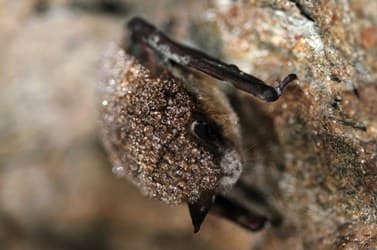Home → Fish & Wildlife → Wildlife → Living with Wildlife → Wildlife Diseases → White Nose Syndrome
White Nose Syndrome

Researchers surveying bats for WNS in Oxford county,
Maine. Photo by Jonathan Mays MDIFW
What is White-Nose Syndrome?
White-nose syndrome (WNS) is a disease that affects bats that hibernate in the winter and is associated with a newly discovered fungus, Geomyces destructans. The disease was named white-nose syndrome because when first discovered, infected bats had white fungus on their muzzles. WNS was first documented in New York in 2006 and has since spread through out the Northeast and Canada. WNS has killed more than 1 million bats in the Northeast, and in several hibernacula (the structure where bats hibernate during the winter) 90 to 100 percent of the hibernating bats have died. We are still learning about WNS fungus but it is presumed that the fungus is transmitted by contact from bat to bat, or by contacting the fungal spores in an infected site. The fungus does attach to clothing and gear and humans are suspected to have transported WNS fungus to some uninfected sites. In 2009, the U.S. Fish and Wildlife Service advised cavers and researchers to curtail caving activities and implement decontamination procedures in an effort to reduce the spread of white-nose syndrome.
WNS in Maine
Surveys for WNS conducted at hibernacula in Maine in 2009 and 2010 found no evidence of WNS. Unfortunately during 2011 surveys, MDIFW biologists found bats at two sites in Oxford County with visible sings of WNS fungus on their wings and muzzles. Carcasses collected from one of the sites were sent to the USGS-National Wildlife Health Center in Madison, WI for diagnostic evaluation for WNS.

Little brown bat with WNS fungus on nose.
Photo by Jonathan Mays MDIFW
On May 20, 2011 MDIFW received results indicating that several of the bat carcasses tested positive for WNS. Bat species that spend their winter in mines or caves, are susceptible to WNS, in Maine those species include:
- Big brown bat (Eptesicus fuscus)
- Little brown bat (Myotis lucifugus)
- Northern long-eared bat (Myotis septentrionalis)
- Eastern small-footed bat (Myotis leibii)
- Tri-colored bat (Pipistrellus subflavus)
How did bats in Maine get WNS?
Until 2011 Maine seemed to be fairly insulated from WNS as occurrences of the disease were popping up in states and provinces all around Maine. We suspect that because we only have a few hibernacula, and relatively few bats during winter in Maine, that it took longer for hibernacula in Maine to become infected. Spores from the fungus associated with WNS may be passed from one bat to another even in the summer, especially when bat gather at maternity roosts. Some little brown bat maternity roosts in Maine have more bats at one site in the summer, than we have at any of our hibernacula during the winter. It is possible that bats that winter in Maine, spend the summer in contact with bats from WNS infected sites in other states, and then carried the fungus back with them to their winter hibernaculum in Maine.
WNS and humans
To date there have been no known illnesses to humans attributed to WNS. Scientists are still learning about WNS but the fungus lives in cold damp environments and we know of no risk to humans from contact with infected bats.
Why do bats matter?
Bats play a critical role in maintaining healthy ecosystems. A recent study published in Science estimates that insect-eating bats provide a significant pest-control service, saving the U.S. agricultural industry at least $3 billion a year. For example the 1 million little brown bats that have already died equates to between 660 and 1320 metric tons of insects that are not being eaten each year.
Unfortunately we do not know the ecosystem impacts that will occur with the population decline and loss of several species of bats.
What we are doing in Maine for bats and WNS?
MDIFW is partnering with other state and federal agencies, and NGOs to monitor bat populations through pre and post pup rearing surveillance and maternity emergence counts.

Little brown bat with WNS fungus on nose.
Photo by Jonathan Mays MDIFW
What you can do?
- Do NOT handle live or dead bats.
- If you have bats roosting in domestic structures, allow them to rear their pups and exit the structure at the end of the summer before closing off any entrance holes. Provide bats with a bat house for when they return next year.
- Do not enter caves or mines in Maine or any eastern state or province during the winter hibernation months. Disturbing bats during hibernation causes them to use limited fat reserves and could cause mortality in already health compromised bats. Also, humans can carry WNS fungus from an infected site and contaminate uninfected sites. For further information on cave closure recommendations and decontamination protocols see USFWS Cavers website
- Report a bat colony
- Learn more about bats in Maine